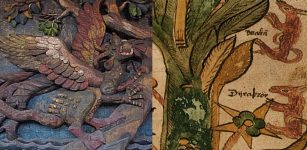Gigantic Neolithic Newgrange Monument: A Temple, Astronomical Observatory Or Ancient Tomb?
A. Sutherland - AncientPages.com - In Ireland, the chambered round cairn of Newgrange, with its quartz walls and a passage aligned towards the midwinter sunrise, was placed inside a circle of over thirty massive blocks of stone. It is a fascinating ancient construction located about 26 miles north of Dublin, Ireland.

Stone at Newgrange - Megalithic art on one of the kerbstones - Image credit: Johnbod - - CC BY-SA 3.0
The gigantic Neolithic tomb of Newgrange (in Irish: Si An Bhru) is one of the world's most impressive prehistoric monuments, probably constructed about 5,100 years ago. The structure is older than the Great Pyramid of Giza and the Stonehenge enormous trilithons.
First written references to Newgrange appear as early as 656 AD in medieval Irish annals, and during the Roman times, Newgrange was already a ruin.
It is believed that the ancient Celts considered the place as an abode of spirits and a former home of their mythological ancestors, "the peoples of the goddess Danu" (Tuatha Dé Danann). Danu was a mother goddess associated with Anu, another Celtic mother goddess who sponsored fertility and prosperity in the land. Some Celtic traditions say that Newgrange belonged to the Daghda ("the good god").
The Celts believed the abandoned prehistoric tombs, such as Newgrange, were portals ('sidh') to the mysterious and dangerous Otherworld, with its subterranean realms and hidden places within the hills.
View of Newgrange, archaeological site of Brú na Bóinne. Image credit: Jean Housen - CC BY-SA 3.0
Professor Michael J. O'Kelly excavated and restored the megalithic passage tomb at Newgrange from 1962 to 1975. He discovered that the builders of Newgrange deliberately oriented the passage so that each year around the winter solstice, the rising Sun's rays would shine through a unique aperture he called a roof box to illuminate the chamber.
Newgrange has a diameter of about 264 ft and is almost circular. Stones layered with turf form the Newgrange's mound, surrounded by 97 large stones, the so-called 'kerbstones' (curbstones), some of which are richly decorated.
Surrounding the Newgrange mound is a ring of 12 standing stones, up to 8 feet in height. There were probably approximately 35 upright stones, but they were destroyed or removed over time.
Newgrange is famous for a spectacular phenomenon occurring at the site every year for a few days around the 21st or 22nd of December. The entrance to the Newgrange passage tomb contains a doorway with two standing stones and a horizontal lintel.
A section of the passage leading towards the chamber of the Newgrange passage tomb in Ireland. Image credit: O'Dea - CC BY-SA 4.0
Above this doorway is the 'roof box' or 'lightbox.' Every year after 9 am (on the early morning of the winter solstice – the shortest day of the year) – the newly risen Sun sends a shaft of sunlight through the Newgrange' light box', creating a narrow beam of light illuminating the central chamber located at the back of the tomb.
The phenomenon lasts 17 minutes, the beam of light slowly disappears, and the chamber is dark again.
It is commonly agreed that the Iron Age Celts did not build Newgrange, but it was unclear how old it really was.
Finally, Professor O'Kelly excavated and restored Newgrange from 1962 to 1975. He discovered that those who built the Newgrange deliberately oriented the passage so that each year around midwinter, the rising Sun's rays would shine through a unique aperture to illuminate the chamber.
Sketch of a cross section of the Newgrange passage grave made by William Frederick Wakeman (d. 1900). Screen capture of PDF version of the 1903 edition converted into black and white and adjusted for contrast and brightness. William Frederick Wakeman - Wakeman's handbook of Irish antiquities (1903). p. 85. - Public Domain
The stone chamber and mound at Newgrange in Ireland has a 'lightbox' allowing the sunrise to be glimpsed briefly on a midwinter day.
According to radiocarbon dating conducted by O'Kelly, Newgrange was constructed in the last centuries of the fourth millennium BC, probably around 3200 BC.
The Newgrange monument's primary functions as a tomb, an astronomical observatory, or an ancient temple celebrating the Sun's union with Mother Earth are often disputed.
Written by – A. Sutherland AncientPages.com Staff Writer
Updated on December 19, 2022
Copyright © AncientPages.com All rights reserved. This material may not be published, broadcast, rewritten or redistributed in whole or part without the express written permission of AncientPages.com
Expand for referencesMore From Ancient Pages
-
 Magical And Malicious Creatures That Prey Upon Yggdrasil In Norse Beliefs
Featured Stories | Dec 6, 2019
Magical And Malicious Creatures That Prey Upon Yggdrasil In Norse Beliefs
Featured Stories | Dec 6, 2019 -
 Rare 2000-Year-Old Celtic Sword Unearthed In East Bohemia
Archaeology | Sep 15, 2020
Rare 2000-Year-Old Celtic Sword Unearthed In East Bohemia
Archaeology | Sep 15, 2020 -
 Lamanai, Belize: One Of The Largest And Oldest Maya Cities Dated To 1500 BC
Civilizations | Nov 2, 2018
Lamanai, Belize: One Of The Largest And Oldest Maya Cities Dated To 1500 BC
Civilizations | Nov 2, 2018 -
 An Intact 4,000-Year-Old Burial Chamber Found In Aswan
Archaeology | Mar 28, 2017
An Intact 4,000-Year-Old Burial Chamber Found In Aswan
Archaeology | Mar 28, 2017 -
 Major Breakthrough: 1.4-Million-Year-Old Bones Discovered In Spain Rewrite History Of Human Evolution In Europe
Archaeology | Sep 29, 2022
Major Breakthrough: 1.4-Million-Year-Old Bones Discovered In Spain Rewrite History Of Human Evolution In Europe
Archaeology | Sep 29, 2022 -
 On This Day In History: Samuel Morey Patents The Internal Combustion Engine – On April 1, 1826
News | Apr 1, 2017
On This Day In History: Samuel Morey Patents The Internal Combustion Engine – On April 1, 1826
News | Apr 1, 2017 -
 Study Traces DNA Of Inca Emperors To Their Modern-Day Descendants
Archaeology | May 29, 2018
Study Traces DNA Of Inca Emperors To Their Modern-Day Descendants
Archaeology | May 29, 2018 -
 Askeladden – Little Trickster That Succeeds Where All Others Fail
Featured Stories | Mar 23, 2018
Askeladden – Little Trickster That Succeeds Where All Others Fail
Featured Stories | Mar 23, 2018 -
 Palnatoke – Founder Of The Jomsvikings Brotherhood, Legendary Danish Hero And Enemy Of King Harald Bluetooth
Historical Figures | Nov 2, 2016
Palnatoke – Founder Of The Jomsvikings Brotherhood, Legendary Danish Hero And Enemy Of King Harald Bluetooth
Historical Figures | Nov 2, 2016 -
 Cnut The Great – England’s Danish King And Ruler Of One Of The Largest Nordic Empires
Featured Stories | Jun 15, 2020
Cnut The Great – England’s Danish King And Ruler Of One Of The Largest Nordic Empires
Featured Stories | Jun 15, 2020 -
 Ancient DNA Sheds New Light On Easter Island Mystery
Archaeology | Oct 13, 2017
Ancient DNA Sheds New Light On Easter Island Mystery
Archaeology | Oct 13, 2017 -
 Rare Ancient Precious Artifacts Found In Rusovce, Slovakia
Artifacts | Sep 26, 2015
Rare Ancient Precious Artifacts Found In Rusovce, Slovakia
Artifacts | Sep 26, 2015 -
 Hundreds Of 19th-Century Skulls Collected In The Name Of Medical Science Tell A Story Of Who Mattered And Who Didn’t
Featured Stories | Nov 14, 2024
Hundreds Of 19th-Century Skulls Collected In The Name Of Medical Science Tell A Story Of Who Mattered And Who Didn’t
Featured Stories | Nov 14, 2024 -
 1154 Ancient Holes At Løykja Reveal Something Extraordinary – Archaeologists Say
Archaeology | Jul 17, 2020
1154 Ancient Holes At Løykja Reveal Something Extraordinary – Archaeologists Say
Archaeology | Jul 17, 2020 -
 The Marduk Prophecy Of Babylonian King Nebuchadnezzar I And The Stolen Statue Of A God
Featured Stories | Jul 4, 2019
The Marduk Prophecy Of Babylonian King Nebuchadnezzar I And The Stolen Statue Of A God
Featured Stories | Jul 4, 2019 -
 Oldest Human Remains From Puerto Rico Reveal A Complex Cultural Landscape Since 1800 BC
Archaeology | Apr 27, 2023
Oldest Human Remains From Puerto Rico Reveal A Complex Cultural Landscape Since 1800 BC
Archaeology | Apr 27, 2023 -
 Extraordinary Archaeological Discovery In Spain
Archaeology | Oct 10, 2023
Extraordinary Archaeological Discovery In Spain
Archaeology | Oct 10, 2023 -
 Great Wall Of India: Massive Structure That Surrounds Ancient Fort Of Kumbhalgarh
Featured Stories | Aug 31, 2015
Great Wall Of India: Massive Structure That Surrounds Ancient Fort Of Kumbhalgarh
Featured Stories | Aug 31, 2015 -
 Prehistoric Spread Of Millet From East Asia To Central Europe – New Study
Archaeology | Jun 10, 2022
Prehistoric Spread Of Millet From East Asia To Central Europe – New Study
Archaeology | Jun 10, 2022 -
 New Inscriptions, Gold And Paint Showed Thanks To Restoration In Temple Of Edfu
Archaeology | Sep 20, 2024
New Inscriptions, Gold And Paint Showed Thanks To Restoration In Temple Of Edfu
Archaeology | Sep 20, 2024



